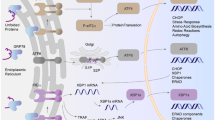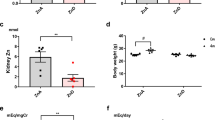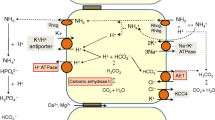Abstract
Dietary deficiency of magnesium (Mg) in rodents results in cardiomyopathic lesion formation. In our rat model, these lesions develop after 3 weeks on the Mg-deficient diet; significant elevation of several cytokines, IL-1, IL-6 and TNFα also occurs. In probing the mechanisms of lesion formation, we obtained data supporting the participation of free radicals (Freedman AMet al.: Bioch Biophys Res Commun 1990; 170: 1102). Recently, we identified an early elevation of circulating substance P and proposed a role of neurogenic peptides during Mg-deficiency (Weglicki WB, Phillips TM: Am J Phys 1992; 262: R734). The present study was designed to evaluate the contribution of neurogenic peptides to the pathogenesis of Mg-deficiency. In the blood, substance-P and calcitonin gene related peptide (CGRP) are elevated during the first week on the diet. During the second week, circulating histamine, PGE2 and TBAR-materials were elevated and red cell glutathione was reduced, all prior to the elevation of the inflammatory cytokines during the third week. When the rats were treated with the substance P-receptor blocker [CP-96,345], the levels of substance P and CGRP remained elevated; however, increases in histamine, PGE2, TBAR-materials, and the decrease in red cell glutathione were inhibited; also, the development of cardiac lesions was inhibited significantly. These data support a central role for neurogenic peptides, especially substance P, in the development of cardiomyopathic lesions during Mg-deficiency.
Similar content being viewed by others
References
Abdelrahman A, Pang CCY: Calcitonin gene-related peptide is a venous dilator in conscious rats. Eur J Pharmacol 217: 185–189, 1992
Altura BM, Altura BT: New perspective on the role of Mg in the pathophysiology of the cardiovascular system. 1. Clinical aspects. Magnesium 4: 226–244, 1985
Atrakchi AH, Bloom S, Dickens BF, Mak IT, Weglicki WB: Hypomagnesemia and isoproterenol cardiomyopathies: Protection by probucol. J Cardiovas Pathol 1: 155–160, 1992
Bost KL, Pascual DW: Substance P: A late-acting B lymphocyte differentiation cofactor. Am J Physiol Cell Physiol 262: C537-C545, 1992
Donnerer J, Stark U, Trithart HA, Lembeck F: CP-96,345, a nonpeptide antagonist of substance P. III. Cardiovascular effects in mammals unrelated to actions on substance P receptors. Naunyn-Schmiedeberg's Arch Pharmacol 346: 328–332, 1992
Freedman AM, Atrakchi AH, Cassidy MM, Weglicki WB: Magnesium deficiency-induced cardiomyopathy: Protection by vitamin E. Biochem Biophys Res Commun 170: 1102–1106, 1990
Freedman AM, Cassidy MM, Weglicki WB: Captopril protects against myocardial injury by magnesium deficiency. Hypertension 18: 142–147, 1991
Freedman AM, Cassidy MM, Weglicki WB: Magnesium-deficient myocardium demonstrates an increased susceptibility to anin vivo oxidative stress. Magnesium Res 4: 185–189, 1991
Freedman AM, Cassidy MM, Weglicki WB: Propranolol reduces cardiomyopathic injury induced by magnesium deficiency. Magnesium and Trace Elements 1993 (in press)
Freedman AM, Mak IT, Stafford RE, Dickens BF, Cassidy MM, Muesing RA, Weglicki WB: Erythrocytes from magnesium-deficient hamsters display an enhanced susceptibility to oxidative stress. Am J Physiol Cell Physiol 262: C1371-C1375, 1992
Griffith OW: Determination of glutathione and glutathione disulfide using glutathione reductase and 2-vinylpyridine. Anal Biochem 106: 207–210, 1980
Heggtveit HA: Myopathy in experimental magnesium deficiency. Ann N Y Acad Scien 162: 758–774, 1969
Heggtveit HA, Herman L, Mishra RK: Cardiac necrosis and calcification in experimental magnesium deficiency. A light and electron microscopic study. Am J Pathol 45: 757–782, 1964
Hsu JM, Rubenstein B, Paleker AG: Role of magnesium in glutathione metabolism of rat erythrocytes. J Nutr 112: 488–496, 1982
Lundberg JM, Franco-Cereceda A, Hua X, Hokfelt T, Fisher JA: Calcitonin Gene-related peptide-like immunoreactivities in sensory nerves in relation to cardiovascular and bronchoconstrictor effects of capsaicin. Eur J Pharmacol 108: 315–319, 1985
Mak IT, Boehme P, Weglicki WB: Antioxidant effects of calcium channel blockers against free radical injury in endothelial cells. Correlation of protection with preservation of glutathione levels. Circ Res 70: 1099–1103, 1992
Mak IT, Kramer JH, Freedman AM, Tse SYH, Weglicki WB: Oxygen free radical-mediated injury of myocytes-protection by propranolol. J Mol Cell Cardiol 22: 687–695, 1990
Matis WL, Lavker RM, Murphy GF: Substance P induces the expression of an endothelial-leukocyte adhesion molecule by microvascular endothelium. J Invest Dermatol 94: 492–495, 1990
McGillis JP, Mitsuhashi M, Payan DG: Immunomodulation by tachykinin neuropeptides. Ann N Y Acad Scien 590: 85–92, 1992
Mulderry PK, Ghatei MA, Rodrigo J, Allen JM, Rosenfield MG, Polak JM, Bloom SR: Calcitonin gene-related peptide in cardiovascular tissues of the rat. Neuroscience 14: 947–954, 1985
Phillips TM: Immunoassays. In: Analytical Techniques in Immunochemistry. Marcel Dekker, Inc, New York, NY 262–300, 1992
Schmidt AW, McLean S, Heym J: The substance P receptor CP-96,345 interacts with Ca2+ channels. Eur J Pharmacol 215: 351–352, 1992
Skofitsch G, Savitt JM, Jacobowitz DM: Suggestive evidence for a functional unit between mast cells and substance P fibers in the rat diaphragm and mesentery. Histochem 82: 5–8, 1985
Weglicki WB, Freedman AM, Bloom S, Atrakchi AH, Cassidy MM, Dickens BF, Mak IT: Antioxidants and the cardiomyopathy of Mg-deficiency. Am J Cardiovasc Pathol 4: 210–215, 1992
Weglicki WB, Phillips TM: Pathobiology of magnesium deficiency: a cytokine/neurogenic inflammation hypothesis. Am J Physiol 263: R734-R737, 1992
Weglicki WB, Phillips TM, Freedman AM, Cassidy MM, Dickens BF: Magnesium-Deficiency elevates circulating levels of inflammatory cytokines and endothelin. Mol Cell Biochem 110: 169–173, 1992
Schmidt AW, McLean S, Heym J: The substance P receptor antagonist CP-96,345 interacts with Ca2+ channels. Eur J Pharmacol 219: 491–492, 1992
Wozniak A, McLennan G, Betts WH, Murphy GA, Scicchitano R: Activation of human neutrophils by substance P: effect on FMLP-stimulated oxidative and arachidonic acid metabolism and on antibody-dependent cell-mediated cytotoxicity. Immunology 68: 359–364, 1989
Author information
Authors and Affiliations
Rights and permissions
About this article
Cite this article
Weglicki, W.B., Mak, I.T., Stafford, R.E. et al. Neurogenic peptides and the cardiomyopathy of magnesium-deficiency: Effects of substance P-receptor inhibition. Mol Cell Biochem 130, 103–109 (1994). https://doi.org/10.1007/BF01457391
Received:
Accepted:
Issue Date:
DOI: https://doi.org/10.1007/BF01457391




